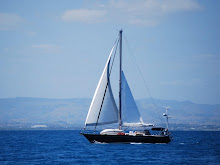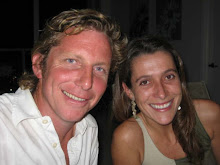
after leaving fakarava we intended to go to kauehi but the current and the wind were against us. we struggled for most of the night and when we were getting closer we noticed we had to waste too much diesel just to try to be at the right hour on the entrance pass to this atoll. therefore when were close to the entrance but several hours away from the appropriate entrance time, we decided to relax, stop the fighting against all weather conditions and the rocking and simply turned where the wind would be in the best side of the boat. once we had the wind behind us and the current in our favor, we simply picked the atoll in front of us as our next stop! Toau was the name of this place. another beautiful place full of sharks, with amazing water to dive and fish.

in the bay we moored (anse amyot)we were lucky to met the couple that lived ashore gaston and valentine, and they had us for dinner in their great little restaurant! we swam with the manta rays, dived and explored this beautiful place with white sand patches and coral heads. After a few days of this paradise, we set sail to the other archipelago of the French Polynesia, the society islands.

Toau.
En Toau terminamos, pero no era nuestro plan, salimos de fakarava al mediodía, como recuerdan, cuando se puede, no cuando se quiere, y navegamos hacia Kauehi.
Nos toco mal clima, corriente en contra, mucho viento y no se daban las condiciones para entrar. Tendríamos que dar vueltas toda la noche para poder entrar con luz.
Decidimos no sufrir más y dirigirnos viento a favor hacia Toau.
A la mañana llegamos y debido a la corriente continua de este lugar, de 3 a 4 nudos, no se puede anclar y toca rápidamente amarrarse de una boya.
El Lugar consta de una pequeña entrada ciega, con 8 boyas en total y el agua de distintos tonos de azules y turquesas.
Aquí vive solo una pareja gaston y valerie, dueños de las boyas y de un pequeño y pintoresco restaurant, que solo lo abren cuando junta a la tripulación de varios barcos.

La vida marina aun es muy rica en estos lugares pocos explotados por el hombre. Nadamos con 8 mantarrayas por una hora en un lindo arrecife. Estos animales dan vueltas en círculo para generar corriente y poder ingerir el plancton del agua. Aunque si uno se les acerca y las imita girando hacia el otro sentido, las mantas terminan imitándolo a uno.
Una vez mas los tiburones hicieron notar su presencia, luego de arponear un par de peces, el arrecife se lleno de varios tiburones, hasta tal punto que decidimos salir del agua. Es increíble como pueden oler la sangre a gran distancia, un pez en agonía, o simplemente el ruido del arpón. Así que amigos, pesca submarina es más que riesgoso por estas latitudes. A la hora de limpiar los peces, lo hicimos desde el dinghy, arrojando las tripas y cabezas al mar, mientras veíamos el espectáculo de 8 tiburones peleándose por la comida. Como verán no hay paraíso perfecto, jaja.





























